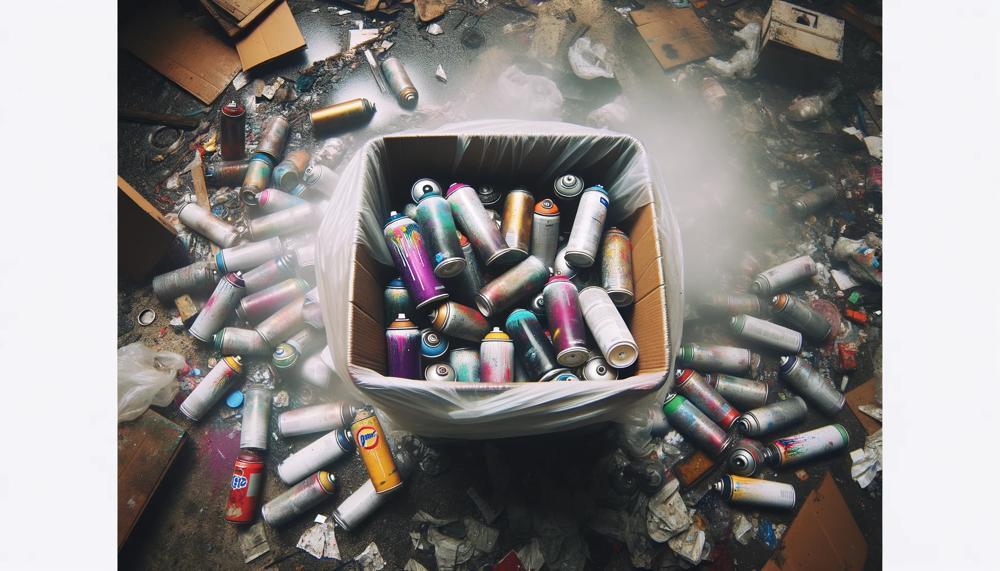Whether you’re a seasoned DIY enthusiast or a newcomer eager to give your space a fresh look, the cleanup process is an essential step not to be missed. Spray paint, while a versatile and effective medium for a wide range of projects, poses unique challenges when it comes to disposal.
In this article, we’ll guide you through the steps to ensure that your post-project process is as smooth and environmentally friendly as your paint job. Our focus will not only be on safeguarding our planet but also on making sure you stay on the right side of the law and best practices.
So, how to dispose of spray paint?
It is legal in California to recycle empty aerosol cans as scrap metal or to dispose of them as solid trash. However, you cannot put non-empty aerosol cans in the domestic recycling collection containers or the garbage. We classify non-empty aerosol cans as hazardous waste and universal trash if they contain potentially dangerous pressurized contents, if the propellant is poisonous or ignitable, or if the product itself is toxic, corrosive, or ignitable.
Here are a few methods for getting rid of spray paint
- Recycle: Empty spray paint cans are free to recycle at county-sponsored mobile events and permanent collection stations. Additionally, you might inquire about whether your neighborhood’s garbage and recycling centers would take empty spray paint cans.
- Collection locations for hazardous waste: Sites for collecting hazardous trash will take spray paint cans, whether they are full or not.
- Particular disposal of dangerous substances is required.: Even if you believe the container is empty, you should still take it to a separate collection for hazardous chemicals if it contains a flammable liquid or one that is often considered hazardous trash.
- Allow the paint to dry: By filling the container with sawdust, wood shavings, or cat litter, you may help the paint dry out. You may dispose of the paint can in the garbage when it has fully dried.
Contents
- 1 How To Dispose Of Spray Paint?
- 2 Understanding the Components of Aerosol Cans
- 3 Recycling Options for Empty Spray Paint Cans
- 4 Puncturing Empty Aerosol Cans: The Safe Disposal Method
- 5 How to Prepare an Empty Spray Paint Can for Recycling
- 6 Companies Using Recyclable Materials for Aerosol Cans
- 7 Local Regulations and Precautions for Safe Disposal of Spray Paint
- 8 Conclusion
How To Dispose Of Spray Paint?
Disposing of spray paint correctly is not just about ticking a box; it’s about safeguarding our planet and our health. Here’s how to do it right:

Completely Empty the Can
First, make sure the can is completely empty. Spray it into a piece of scrap material until nothing comes out.
This reduces the risk of harmful chemicals affecting our environment and health.
Recycle Where Possible
If your area supports it, recycling is your next step.
Many spray paint cans are made of steel or aluminum, which are highly recyclable materials.
Hazardous Waste Collection
For cans that still have paint inside, your local hazardous waste collection event is the place to be.
They’ll take care of it the right way.
Proper Storage
Until you can dispose of or recycle the can, store it in a cool, dry place away from sunlight and heat sources.
This keeps the risks at bay.
Spread the Word
Educate your mates about how to dispose of these cans. The more people know, the safer our planet will be.
Why bother? Well, chucking these cans wrongly can mess up our water, harm aquatic life, and even cause explosions.
Doing it right means we’re looking after our world and everyone in it.
Table of Safe Disposal Practices
| Action | Reason | Benefit |
| Empty the can | Reduces environmental hazards | Less pollution |
| Recycle | Minimises landfill waste | Preserves resources |
| Hazardous waste collection | Safe disposal of chemicals | Protects ecosystems |
| Proper storage | Avoids risks of heat exposure | Prevents accidents |
| Educate others | Spreads responsible practices | Community safety |
Correct disposal of spray paint cans isn’t just good practice; it’s a duty to our planet and future generations.
Understanding the Components of Aerosol Cans
| Component | Role in Aerosol Can | Importance in Disposal |
| Can | Container under pressure | Ensure empty, puncture for safety |
| Valve | Controls release | Fully depress to release contents |
| Propellant | Enables spraying | Release all propellant before recycling |
| Product | Content (e.g., paint) | Follow specific disposal instructions |
The art of disposing spray paint cans calls for understanding these components and their roles.
Recycling Options for Empty Spray Paint Cans
Recycling empty spray paint cans is crucial for keeping our planet tidy and safe. Here’s how you can do your bit:
Make Sure They’re Empty
First off, ensure the can is truly empty. Shake it. If there’s no sound, you’re good to go. This simple act can significantly reduce the risk to our environment.
Know Your Local Rules
Different places have different rules. A quick call or a browse on your local council’s website can save you a headache and keep you in the clear legally.
Don’t Forget Safety
Never puncture or attempt to crush an aerosol can. Not only is it dangerous, but it could also be against the law. Leave that to the professionals who know how to handle them safely.
Puncturing Empty Aerosol Cans: The Safe Disposal Method
Why Recycle?
- Environmental Conservation: Recycling cans keeps them out of landfills and conserves natural resources.
- Energy Efficiency: Repurposing materials from aerosol cans, like aluminium or steel, saves a substantial amount of energy.
How to Recycle Right
- Preparation: Ensure cans are utterly empty. Remove plastic caps and ensure no remnants linger within.
- Local Guidelines: Check with local recycling centers; acceptance varies based on regional policies.
Puncturing: A Professional’s Chore
Understanding the Method
- Depressurization: Specialised devices puncture cans, safely releasing any residual pressure or content.
- Precaution: This process must only be conducted by those with the right expertise to avoid accidents.
When to Consider Puncturing
- Non-Recyclable Cans: For cans that cannot be recycled due to hazardous contents, puncturing offers a safe disposal method.
How to Prepare an Empty Spray Paint Can for Recycling
To prep an empty spray paint can for the recycling adventure, follow these nifty steps. It’s like setting sail, ensuring every part of the ship is shipshape before the voyage.
| Step | Action | Why It’s Done |
| Use Up the Paint | Empty the can on a scrap piece of cardboard. | To minimize hazardous waste and simplify cleaning. |
| Peel Off Labels | Remove labels and stickers with a blade. | Makes recycling smoother by removing potential contaminants. |
| Detach Extras | Take off any plastic caps or nozzles. | Separate materials for proper recycling sorting. |
| Clean the Can | Wipe out any residue with mineral spirits, then rinse. | Ensures the can is free of hazardous leftovers. |
| Vent the Can | Puncture a hole in the bottom in a safe area. | Releases pressurized air, making recycling safer. |
Companies Using Recyclable Materials for Aerosol Cans
In the quest to keep our planet a bit greener and the oceans a tad bluer, a bunch of forward-thinking companies have rolled up their sleeves to tackle the environmental bogeyman—non-recyclable packaging.
Aerosol cans, those nifty little containers we often take for granted, are getting a sustainable makeover. Let’s zero in on the champs turning the tide by embracing recyclable materials for their aerosol cans.
| Company | Industry | Recyclable Material Used |
| L’Oreal | Beauty | Recyclable Aluminum |
| Unilever | Consumer Goods | Recycled Steel |
| Nestle | Food | 100% Recycled Aluminum |
Local Regulations and Precautions for Safe Disposal of Spray Paint
To dispose of spray paint safely and abide by local regulations, one must be vigilant and informed. Here’s a detailed breakdown of steps and precautions:
Understand Local Regulations:
Each locality has its unique set of rules for hazardous waste disposal. It’s pivotal to get the lowdown on these from your local waste management authority or city office.
Safe Disposal Steps:
- Ensure the Can is Empty: Shake the can and spray onto a piece of scrap until nothing comes out. This minimizes the hazard.
- Don’t Puncture or Burn: Aerosol cans are like ticking bombs if punctured or exposed to extreme heat. Leave them intact.
- Recycling Centers: Some centers welcome empty aerosol cans. Call ahead to check.
- Hazardous Waste Collection: Many areas have designated days for hazardous waste. It’s a smart move to take advantage of these.
- Donation: If there’s still life in your can, consider donating it to a local school or community center.
- Proper Storage: While waiting for disposal, keep cans in a cool, dry spot away from sunlight.
Eco-friendly Choices:
Opting for products with recyclable packaging or less harmful alternatives can make a significant difference in reducing environmental footprint.
Conclusion
Creating a sustainable future is not only about creative endeavors; it also includes the last, responsible step of properly discarding spray paint cans. Before we start on our environmentally friendly trip, we must make sure that every can is completely empty of its contents. This is a simple action that will have a significant influence on lowering environmental risks. Recycling becomes a noble endeavor, reducing the amount of garbage that ends up in our landfills and converting old cans into useful materials.
Specialized hazardous waste collectors are prepared to handle paint cans that are still holding paint, guaranteeing a compliant and safe disposal process. By temporarily keeping cans in a cool, dry location, we protect our surroundings from possible threats. Creating a ripple effect of peers being aware of appropriate disposal techniques increases the group’s gain and protects our common environment.
This story demonstrates our dedication to the environment and goes beyond just eradicating garbage. By following these guidelines, we not only abide by the law but also make the world a cleaner, healthier place. The ecosystem is resonant with the echo of human activities, providing a chorus of preservation and concern.





